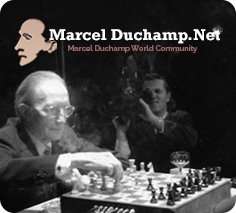1. PUBLICATIONS
Electricity widthwise
The only possible use
of electricity “in the arts”
-Marcel Duchamp, from the Box Of 1914
The first interactive, multi-media journal focusing on the French-American artist Marcel Duchamp (1887-1968), Tout-Fait convenes international scholars and writers in the arts, sciences, and many other fields of study. Tout-Fait is an interdisciplinary project committed to presenting articles, interviews, news and short notes concerning one of modern art’s most important figures and his circle. With over 150,000 visitors since its inauguration, and growing, Tout-Fait’s internet presence has become the accredited resource for Duchampian study as well as an asset of historical significance on the development of the modern art movement.
Without the restrictions of the print media, Tout-Fait presents an expanded field of studies that permits a fluidity of thought and form while generating a dialogue among established thinkers, young scholars and the interested public. In the spirit of Duchamp’s work, Tout-Fait offers heightened visual capabilities and interactivities, producing a unique set of scholarly tools for contributors and readers to use. There is extensive access to the vast amount of articles, notes, and letters in the journal; the Bulletin Board, which encourages a level of exchange previously unavailable through print publications; and unlimited capability for color reproductions and the manufacture of sound, video and animation to enhance the potential of critical thinking.
Utilizing the velocity of electronic publishing, storage, and communication, Tout-Fait successfully embodies a general prototype and ideal for this online academic journal, offering heightened visual quality and interactivities to challenge the conventional methodologies of scholarship. Tout-Fait welcomes submissions of critical thinking and encourages multiple authorship. All articles are first publications. Foreign submissions (once accepted) may be published in both their original language and in English translation.
Please click for submission guidelines; or email us at info@toutfait.com.
Or visit us at www.toutfait.com
2) The Marcel Duchamp World Community
Functioning as a gateway to The Marcel Duchamp World Community, marcelduchamp.net offers a neutral, unbiased, interactive environment for the meeting and exchange of ideas within the global community of Duchamp studies. Visitors can glance at biographical information of Marcel Duchamp, a key figure in the development of modern art; discover recommended articles; link to Tout-Fait: The Marcel Duchamp Studies Online Journal, as well as links to sites in arts and cultures on the World Wide Web. Marcel Duchamp Studies Online Bulletin Board is accessible from the site as well.
We welcome news, events, publications, and papers — anything related to Marcel Duchamp and his circle of friends in Dada and Surrealism.
Visit at: www.marcelduchamp.net
Shortly after Marcel Duchamp completed his posthumously revealed work, Etant donnés: 1° la chute d’eau, 2° le gaz d’éclairage (Given: 1° the waterfall, 2° the illuminating gaz), he set out to prepare an illustrated manual of instructions for disassembly and reconstruction of the work, which was essential to Duchamp’s task of moving the assemblage to another location.
The Manual can be seen as an artwork per se, and as an inseparable element of Given.In 2001, ASRL published a digital version of the Manual of Instruction based on the 1987 reproduction of the original copy by the Philadelphia Museum of Art. The digital version of the Given Manual features an interactive environment and navigation system, allowing users to intuitively follow the friendly interfaces. Important functions include the ability to switch between the original French and the English translation, rotating the page 90 degrees, zooming in and out, jumping to specific pages, and thumbnailing images for easy cross-reference.
Art is an outlet toward regions which are not ruled by time and space. -Marcel Duchamp, 1956 Given In Time: Marcel Duchamp’s “1° the waterfall, 2° the illuminating gaz”- a chorology from 1911 to 1988 is a comprehensive survey on Ducmap’s posthumous work, Given: 1° the waterfall, 2° the illuminating gaz (1946-1966).Divided into three trajectories representing, respectively, the artist’s perspective, the spectator’s perspective and the compilation of all events across time and space, this digital publication examines Duchamp’s lifelong writings and works pertaining to the utmost realization of Given in 1966. The artist’s perspective starts from a handwritten note in 1911 where the title of Given first appeared until the exhibition announcement of Door designed by Duchamp in 1966. The spectator’s perspective originates from the time when the 1911 note was first shown to the public in 1931 and ends in 1998 with the discovery of a photograph of a female torso. Finally, the trajectory of all events combines both perspectives, offering an inclusive overview of a private and public realm as the completion of the creative act. As Duchamp stated, “All in all, the creative act is not performed by the artist alone; the spectator brings the work in contact with the external world by deciphering and interpreting its inner qualifications and thus adds his contribution to the creative act.”Adding to the time curves, Given in Time also features audios, videos, animations, text explanations, and the digital reproduction of the Philadelphia Museums of Art Bulletin, “Etant donné: 1° la chute d’eau, 2° le gaz d’éclairage, Reflections on a New Work by Marcel Duchamp.” We are deeply grateful for the support of the Philadelphia Museum of Art, Ms. Ann d’Harnoncourt, Mr. Walter Hopps, and especially the Succession Marcel Duchamp in Paris.
2. MARCEL DUCHAMP RESEARCH
Click to see the article
2) Shear/Gould Science Article on Duchamp’s Rotoreliefs
Click to see the article
3) Animated Analysis of the Poster for the Third French Chess Championship
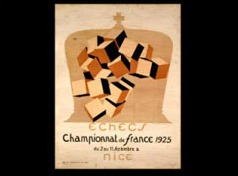
Duchamp purportedly determined the position of the cubes for the Poster for the Third French Chess Championship, 1925 by tossing cubes into a net bag and then photographing it, If the positions of the cubes on the poster are indeed a simple transfer from the photograph of randomly tossed cubes, should scientific method serve as an empirical approach to rationalize the seemingly undebated process?
Rhonda Roland Shearer and Robert Slawinski experimented, using computer modeling and animation to generate the spatial positions as Duchamp’s poster depicted, as compared with the scientific perspective of the cubes. Supposedly, the depiction of the cubes on the Poster would have to be in harmony with the physical reality of the actual fallen cubes, with interpenetrating surfaces, vanishing angles and vertices. However, the result of the analysis is surprising!
“CUBIST ART IS HERE AS CLEAR AS MUD,” the Chicago Herald-Tribune blasted in 1913. Chicagoans did not understand the new, European modernist art any more than New Yorkers did when the famous Armory Show arrived that same year. It is easy to forget that futurist, cubist and post-impressionist art once provoked a reaction similar to the recent Brooklyn “Sensation Exhibition” sensation. Rudy Giuliani is only a mayor creating a fuss, after all. When the Armory Show hit the Big Apple in 1913, President Teddy Roosevelt weighed in by writing that Duchamp’s Nude Descending looked to him like a Navajo Indian rug.Animation 4 attempts to visualize this President’s “bully for you” interpretation of Duchamp’s work. Shearer hopes that the three newspaper cartoons, when transformed into animations, will give spectators a more enlivened sense of the public’s reaction and commentary than the static, historical images usually rendered.In Animation 1,2 and 3, spectators will find, respectively, the moving confusion of a crowded subway escalator filled with rude New Yorkers; the prototype of bad boy cubists (a quilt-making Grandma); and a frustrated New York gent literally flipping his “lid” and standing on his head but still not “getting” it. Finally, development of Animation 5, using the classic Armory still photo showing old cars and horse carriages waiting for patrons to return from viewing the scandal, takes advantage of the latest in animation technology and after-effects to emphasize what we most forget when we now look at modernist works–it was a much different “high button shoe/top hat world” in 1913 when Duchamp’s works first came to town…”Hey watch the horse shit.”
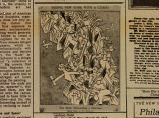
Animation of J.F. Griswald’s “Seeing New York with a Cubist: The Rude Descending a Staircase (Rush Hour in the Subway).” The Evening Sun, March 20, 1913. Reprint: Philadelphia Museum of Art, 1973, in: Marcel Duchamp July 28, 1887 – October 2, 1968 (two-page memorial newspaper published on the occasion of the museum’s 1973 Duchamp-retrospective). Animation by Junghee Choi and Rhonda R Shearer; text complied by Thomas Girst.
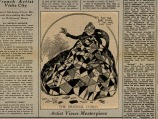
Animation of J.F. Griswald’s “Seeing New York with a Cubist: The Rude Descending a Staircase (Rush Hour in the Subway).” The Evening Sun, March 20, 1913. Reprint: Philadelphia Museum of Art, 1973, in: Marcel Duchamp July 28, 1887 – October 2, 1968 (two-page memorial newspaper published on the occasion of the museum’s 1973 Duchamp-retrospective). Animation by Junghee Choi and Rhonda R Shearer; text complied by Thomas Girst.
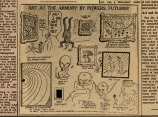
Reprint: Utica. Munson-Williams-Proctor Institute. 1913 Armory Show 50th Anniversary Exhibition, 17 February – 15 March 1963, p. 174 (traveled to: New York. Armory of the Sixty-Ninth Regiment, 6-28 April 1963). Animation by Junghee Choi and Rhonda R Shearer; text complied by Thomas Girst.
(exterior of the 69th Regiment Armory at 305 Lexington Avenue and 25th Street, New York)
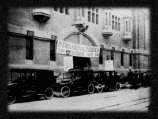
New York. Armory of the 69th Regiment. “International Exhibition of Modern Art”. 17 February – 13 March, 1913 (traveled to Chicago. Art Institute of Chicago, 24 March – 15 April 1913; Boston. Copley Hall, 28 April – 18 May, 1913) In his preface to the catalog for the “International Exhibition of Modern Art” (a.k.a. “Armory Show”), Frederick James Gregg quotes Arthur B. Davies, president of the Association of American Painters and Sculptors, the show’s newly formed organizing society: “[T]he time has arrived for giving the public here the opportunity to see for themselves the results of new influences at work in other countries in an art way. In getting together the works of the European Moderns, the society has embarked on no propaganda. […] Its sole object is to put the paintings, sculptures, and so on, on exhibition so that the intelligent may judge for themselves by themselves.” With almost two thousand works on view and close to 100,000 visitors in New York alone, the Armory Show introduced the United States to modern European Art. The press extensively covered the event, making Marcel Duchamp’s Nude Descending a Staircase No.2 (1912) the show’s succès de scandale. The Cubist room was soon dubbed “The Chamber of Horrors,” while Duchamp’s painting was described as “a lot of disused golf clubs and bags,” “an explosion in a shingle factory” and an “academic painting of an artichoke.”
Animation by Alvarez Greg and Rhonda R Shearer; text complied by Thomas Girst.
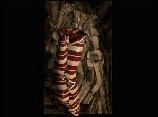
On March 22nd, 1913, Theodore Roosevelt’s “A Layman’s Views of an Art Exhibition” was published in The Outlook. Misquoting the name of Marcel Duchamp’s infamous painting, Nude Descending a Staircase No. 2, he wrote: “Take the picture which for some reason is called A naked man going down stairs. There is in my bathroom a really good Navajo rug which, on any proper interpretation of the Cubist theory, is a far more satisfactory and decorative picture. Now if, for some inscrutable reason, it suited somebody to call this rug a picture of, say, A well-dressed man going up a ladder, the name would fit the facts just about as well as in the Cubist picture of the Naked man going down stairs. From the standpoint of terminology each name would have whatever merit inheres in a rather cheap straining after effect; and from the standpoint of decorative value, of sincerity, and of artistic merit, the Navajo rug is infinitely ahead of the picture.”
President Theodore Roosevelt had visited the Armory Show on March 4th, 1913, the day president-elect Woodrow Wilson was taking the oath of office. Animation by Junghee Choi and Rhonda R Shearer; text complied by Thomas Girst.
3. MARCEL DUCHAMP COLLECTION
Hitherto the leading Marcel Duchamp collection in private hand, ASRL’s Duchamp collection have primarily focused on the acquisitions of works by Duchamp in conjunction with collections of historical objects and reference materials relevant to one of the most important figures in the development of modern art.
Acknowledging the importance and responsibility of creating special collections as integral and parallel activities to curatorial practice and education, ASRL is committed to the approach of collection-research and cross-disciplinary study. The strategy is especially rewarding in the case of Duchamp study, given the importance of Duchamp’s active utilization of objects and materials from everyday life–objects that are rapidly disappearing not only from our understanding, but also as material and collectible entities. Cross-disciplinary studies have long been promoted in theory as an idealized vision for scholarship, yet rarely in practice. Collections of historical object and records parallel to collections of art objects promise not only preservation of our cultural heritage but also an active matrix for cross-disciplinary research in the arts. By studying humble and ephemeral historical objects, scholars can gain important insights about the cultures and economies that surround the lives of artists and set the contexts of their important works.
As opposed to static storage and display in libraries and art museums, we envision the future of scholarship where culture and objects meet for constructive learning environment. ASRL’s collection is free and accessible for scholars, students, and the public. Please contact us for appointment prior to the visit.
4. HARVARD SYMPOSIUM AND PROCEEDINGS
“METHODS OF UNDERSTANDING IN ART AND SCIENCE:
The Case of Duchamp and Poincaré”
November 5-7, 1999
Harvard University Science Center
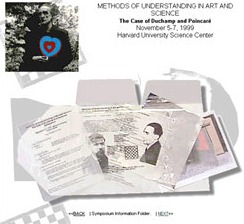
The “Method of Understanding in Art and Science: The Case of Duchamp and Poincaré” took place at Harvard University Science Center on November 5-7, 1999. The Symposium aimed at examining concerns, relevant to and shared by the mathematician-philosopher Henry Poincaré and artist Marcel Duchamp, pertaining to issues that also promise to integrate the methodology and subject matter of art and science. During the three-day sessions, topics encompassed scholarly discussions such as unconscious intuition and choice during the creative process, the importance of doubt, the beauty of “gray matter” (mental beauty), and probabilistic systems sensitive to initial conditions in nature. Participants in this celebrated event were internationally acclaimed physicists, mathematicians, artists, and art historians including Gerald Holton, Arthur C. Danto, Hector Obalk, Bonnie Clearwater, Madeline Gins, Richard L. Gregory, David Joselit, Richard Brandt, André Gervais, Dieter Daniels, Craig Adcock, Herbert Molderings, Rhonda Roland Shearer, and the late professor Stephen Jay Gould.
Sponsored by Harvard’s Department of History of Art and Architecture and the Department of the History of Science, the symposium proves successful at generating and furnishing discussions on the interactions, too often strained, between art and science. As a result, ASRL currently is pursuing a publication of the Symposium Proceedings to summarize and document the intellectual momentum of artscience in the format of a printed anthology.
For more information about the program schedules and sessions, please visit the Harvard Symposium page. If you would like to be notified as to the date of publication and its availability, please contact us at info@toutfait.com.
5. PROTOTYPE OF THE FUTURE: Paul Mellon 21th Century Exhibition and Study Room
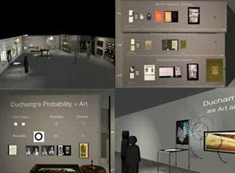
Originally presented as an exhibition proposal to the Yale University Art Gallery, “Hidden in Plain Sight: Decoding Duchamp’s Art and Science” foresees the future for museum art exhibitions. We envision an innovative installation of Marcel Duchamp’s works which would include hands-on participation and new, amazing (but friendly) computer technology, all of which will not only enhance public understanding of modern art, but at the same time will break the artificial boundaries between art and science, and accomplish much needed education as such.
Since most of the original ready-mades have been lost and are visible only in photographs, on display are three-dimensional models have been crafted based on the originals in the photographs or historical artifacts. To serve as a “hands-on” exercise, viewers can touch them and use them for their own critical observations and “experiments.” Features of computer technology involve visualization and measuring of “lost ready-mades” and optical machines in virtual space. Pushing several buttons, visitors will be able to rotate Duchamp’s objects on a monitor, turn and view them from all sides. In addition, the perspective in Duchamp’s photographs, paintings and drawings can be easily and accurately checked without laborious, and often inaccurate, hand-drawn geometries.
These QuickTime movies contain animations originally produced as part of the proposal for “Hidden in Plain Sight”. Presented to the Yale University Art Gallery in 1998, the interactive space encompasses the most complete collection ever assembled on objects by Marcel Duchamp. As the four-part virtual tours reveal, the installation of the exhibit is a hybrid space designed for the study, exhibition and storage of Duchamp’s works, in a hands-on environment. We believe that end results of such an entertaining, informative, and unusual exhibition will be a broader attendance for art museum, popularity with the press, new enthusiasm from funding sources, and most importantly the profound and long-term impact on public education in art, science and culture.

